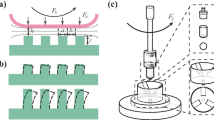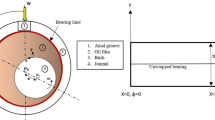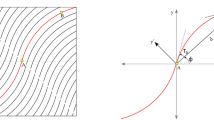Abstract
As the state of the art pushes triboelements toward greater capabilities and longevity, the need for evolving triboelement technology exists. The following work explores a novel coupling of phenomena inspired by biomimetics. A poroviscoelastic substrate coupled to a fluid film load is modeled and compared to its rigid counterpart. It is hypothesized that poroviscoelasticity can improve triboelement properties such as damping and wear resistance and have utility in certain applications where flexibility is desired (e.g., biomechanical joint replacements, flexible rotordynamic bearings, and mechanical seals). This study provides the framework for the analysis of flexible, porous viscoelastic materials and hydrodynamic lubrication.










Similar content being viewed by others
Abbreviations
- a :
-
Film inlet to outlet ratio (\(h_\mathrm{i}/h_\mathrm{o}\))
- B :
-
Biot poroelastic constant
- D :
-
Bearing pad depth
- \(E_n\) :
-
Fractional calculus viscoelastic parameter
- h :
-
Fluid film thickness
- \(h_\mathrm{i}\) :
-
Inlet fluid film thickness
- \(h_\mathrm{o}\) :
-
Outlet fluid film thickness
- H :
-
Bearing pad height
- k :
-
Permeability
- K :
-
Biot poroelastic constant
- L :
-
Bearing pad length
- p :
-
Pore pressure in substrate pad
- P :
-
Fluid film pressure
- u :
-
Fluid velocity in x direction
- \(U_1\) :
-
Bearing velocity
- \(U_x\) :
-
Filter velocity in x direction
- \(U_y\) :
-
Filter velocity in y direction
- \(\alpha\) :
-
Beavers–Joseph slip coefficient
- \(\alpha _\mathrm{B}\) :
-
Biot poroelastic constant
- \(\delta _{ij}\) :
-
Kronecker delta (index notation)
- \(\lambda\) :
-
Fractional calculus viscoelastic parameter
- \(\mu\) :
-
Lubricant viscosity
- \(\epsilon _{ij}\) :
-
Strain
- \(\sigma _{ij}\) :
-
Stress
- \(\sigma ^*_{ij}\) :
-
Effective stress in porous material
- \((\sigma _\mathrm{ve})_{ij}\) :
-
Viscoelastic stress
- \(\xi\) :
-
Porous film thickness modifier
- \(\zeta\) :
-
Poroelastic fluid strain
References
ABAQUS: Abaqus Documentation 6.14. Dassault Systems Simulia Corp., Providence, RI, USA (2014)
Beavers, G., Joseph, D.: Boundary conditions at a naturally permeable wall. J. Fluid Mech. 30, 197–207 (1967)
Biesel, V.: Experimental measurement of the dynamic properties of viscoelastic materials. Master’s thesis, Georgia Institute of Technology (1993). https://books.google.com/books?id=UfzItgAACAAJ
Biot, M.A.: Le problme de la consolidation des matires argileuses sous une charge. Ann. Soc. Sci. Bruxelles B55, 110–113 (1935)
Biot, M.A.: General theory of three-dimensional consolidation. J. Appl. Phys. 12, 155–164 (1941)
Biot, M.A.: Theory of stress-strain relations in anisotropic viscoelasticity and relaxation phenomena. J. Appl. Phys. 25(11), 1385–1391 (1954)
Biot, M.A.: Dynamics of viscoelastic anisotropic media. In: Proceedings of the Fourth Midwestern Conference on Solid Mechanics, Purdue University (Publication no 129 engineering experiment station, Purdue University, Lafayette, IN), pp. 94–108, September 8–9 (1955)
Biot, M.A.: Theory of elasticity and consolidation for a porous anisotropic solid. J. Appl. Phys. 26, 182–185 (1955)
Biot, M.A.: Variational and lagrangian methods in viscoelasticity. In: Grammel, R., (ed.) Deformation and Flow of Solids. Springer, New York (1955)
Biot, M.A., Willis, D.: The elastic coefficients of the theory of consolidation. J. Appl. Mech. 24, 594–601 (1957)
Bishop, A.W.: The use of pore-pressure coefficients in practice. Gotechnique 4(4), 148–152 (1954). doi:10.1680/geot.1954.4.4.148
Etsion, I., Halperin, G.: A laser surface textured hydrostatic mechanical seal. Tribol. Trans. 45(3), 430–434 (2002)
Etsion, I., Michael, O.: Enhancing sealing and dynamic performance with partially porous mechanical face seals. Tribol. Trans. 37(4), 701–710 (1994). doi:10.1080/10402009408983349
Gurtin, M.E., Sternberg, E.: On the linear theory of viscoelasticity. Arch. Ration. Mech. Anal. 11(1), 291–356 (1962). doi:10.1007/bf00253942
Hamrock, B., Schmid, S., Jacobson, B.: Fundamentals of Fluid Film Lubrication. Mechanical engineering. CRC Press (2004). https://books.google.com/books?id=s_sTzyB2QmYC
Miller, B., Green, I.: Numerical formulation for the dynamic analysis of spiral-grooved gas face seals. J. Tribol. 123, 395–403 (2001)
Prakash, J., Vij, S.: Analysis of narrow porous journal bearing using Beavers–Joseph criterion of velocity slip. J. Appl. Mech. 41(2), 348–354 (1974)
Skempton, A.W.: The pore-pressure coefficients a and b. Gotechnique 4(4), 143–147 (1954). doi:10.1680/geot.1954.4.4.143
Smyth, P.A., Green, I.: A fractional calculus model of articular cartilage based on experimental stress-relaxation. Mech. Time Depend. Mater. 19(2), 209–228 (2015)
Smyth, P.A., Green, I., Jackson, R.L., Hanson, R.R.: Biomimetic model of articular cartilage based on in vitro experiments. J. Biomim. Biomater. Biomed. Eng. 21, 75–91 (2014)
Szumski, R.G., Green, I.: Constitutive laws in time and frequency domains for linear viscoelastic materials. J. Acoust. Soc. Am. 90(40), 2292 (1991)
Terzaghi, K.: Die berechnung der durchlassigkeitsziffer des tones aus dem verlauf der hydrodynamischen spannungserscheinungen. Sitz. Akad. Wissen. Wien Math. Naturwiss. Kl. Abt. IIa 132, 105–124 (1923)
Wang, H.: Theory of linear poroelasticity with applications to geomechanics and hydrogeology. Princeton series in geophysics. Princeton University Press (2000). https://books.google.com/books?id=RauGOzaQBRUC
Wilson, W., van Donkelaar, C.C., van Rietbergen, B., Ito, K., Huiskes, R.: Stresses in the local collagen network of articular cartilage: a poroviscoelastic fibril-reinforced finite element study. Journal of Biomechanics 37(3), 357–366 (2004). doi:10.1016/s0021-9290(03)00267-7. http://www.sciencedirect.com/science/article/pii/S0021929003002677
Author information
Authors and Affiliations
Corresponding author
Rights and permissions
About this article
Cite this article
Smyth, P.A., Green, I. Analysis of Coupled Poroviscoelasticity and Hydrodynamic Lubrication. Tribol Lett 65, 1 (2017). https://doi.org/10.1007/s11249-016-0787-3
Received:
Accepted:
Published:
DOI: https://doi.org/10.1007/s11249-016-0787-3




